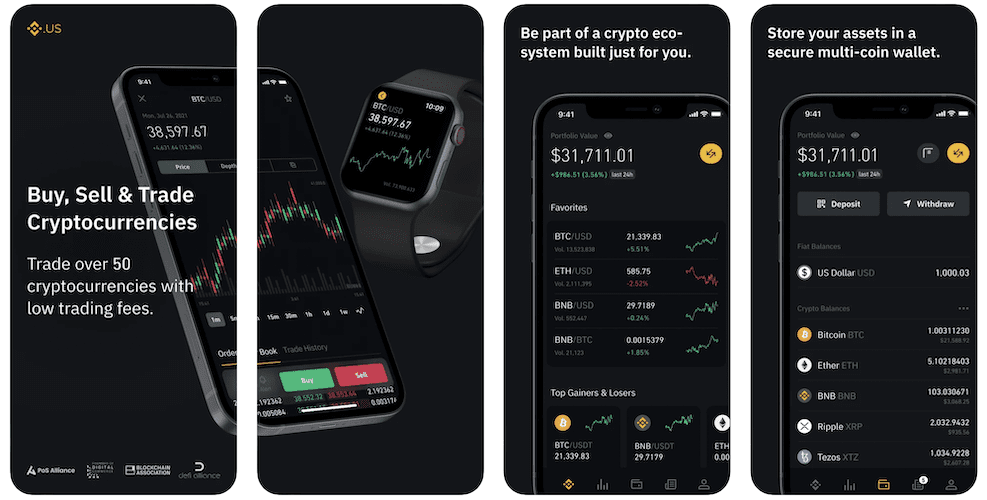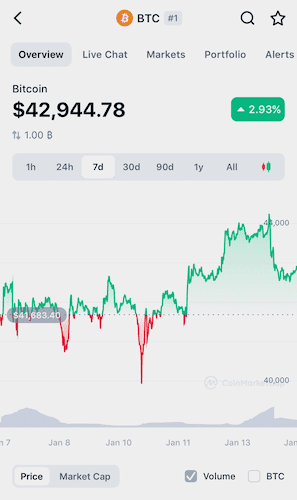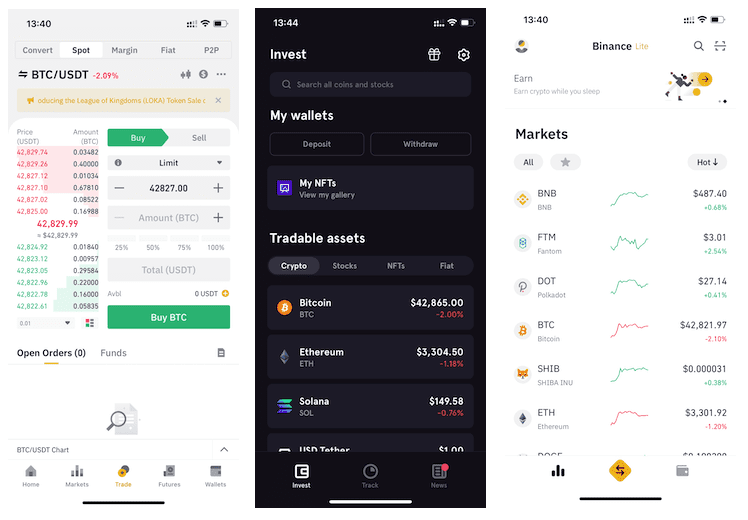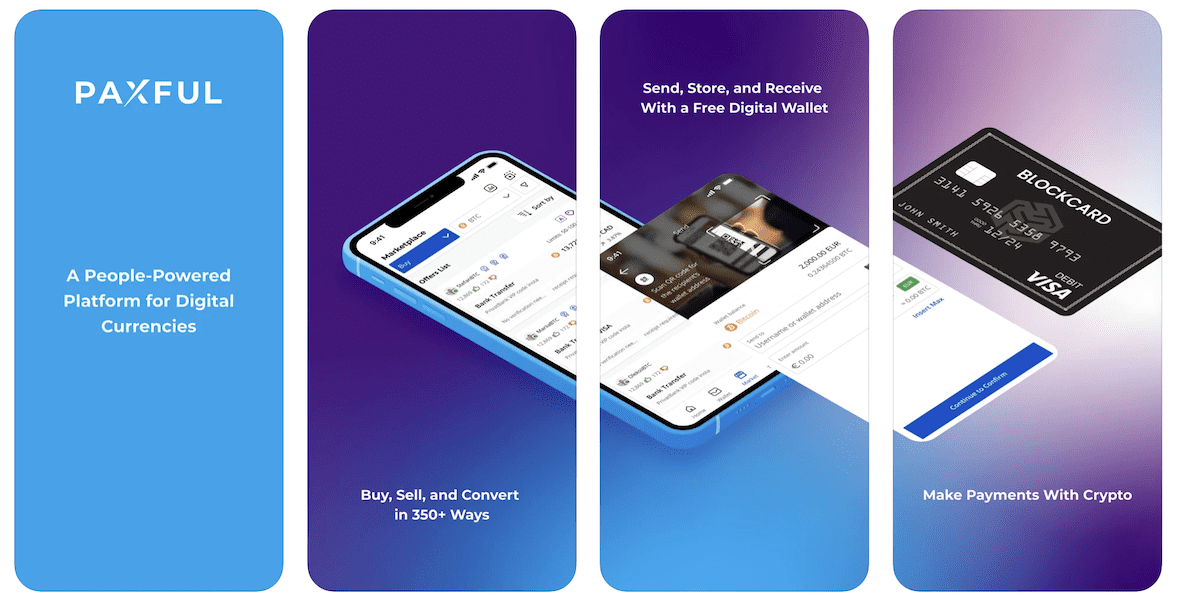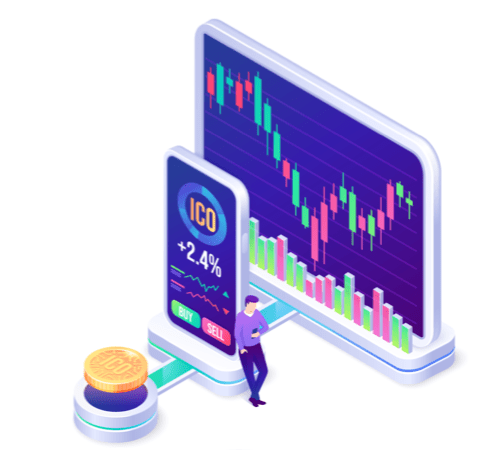If you think you may be losing customers to an outdated mobile experience and need a second opinion on how to fix that, you’re in the right place.
I’ve scrutinized 20 crypto trading applications to pinpoint the successful path to mobile crypto trading app development. In this blog, you’ll find the best practices and a complete walkthrough for building a cryptocurrency app for iPhones and Android phones.
Whether you are starting from scratch or looking to augment an existing app, here’s an excellent place to get going with your research.
Top Takeaways:
- One can build three types of crypto trading apps: typical centralized apps a la CoinBase or Binance, peer-to-peer cryptocurrency trading apps, and decentralized apps for exchanging crypto.
- The main challenge on your way to creating crypto trading apps will be optimizing designs for newbies and pros at the same time. Your mileage may differ, but I noticed that most advanced crypto trading apps look way too overwhelming, even to pro traders.
- One workaround is to build separate apps for newcomers and experienced users. Another is to combine both UX/UI variants in a single app and allow customers to switch between them. Yet another scenario is to focus on one group of users when you make a crypto trading app.
Table of Contents:
- Crypto-Trading Apps Market Overview
- The Caveat
- Must-Have Features of a Crypto Trading App
- Advanced Features of a Crypto Trading App
- Steps to Develop a Crypto Trading App
- The Cost of Creating a Crypto Trading App
Crypto-Trading Apps Market Overview
If you look at the top 20 finance apps in the App Store today, you’ll notice at least five crypto trading apps, e.g., FTX, CoinBase, and Crypto.com. A more thorough review will reveal even more applications allowing users to buy and sell crypto. Crypto is absolutely in the air.
The 24-hour trading volume of the leading 25 crypto exchanges counts in billions. So it’s no surprise that the fintech app development space attracting so much financial power is captivating entrepreneurs’ attention.
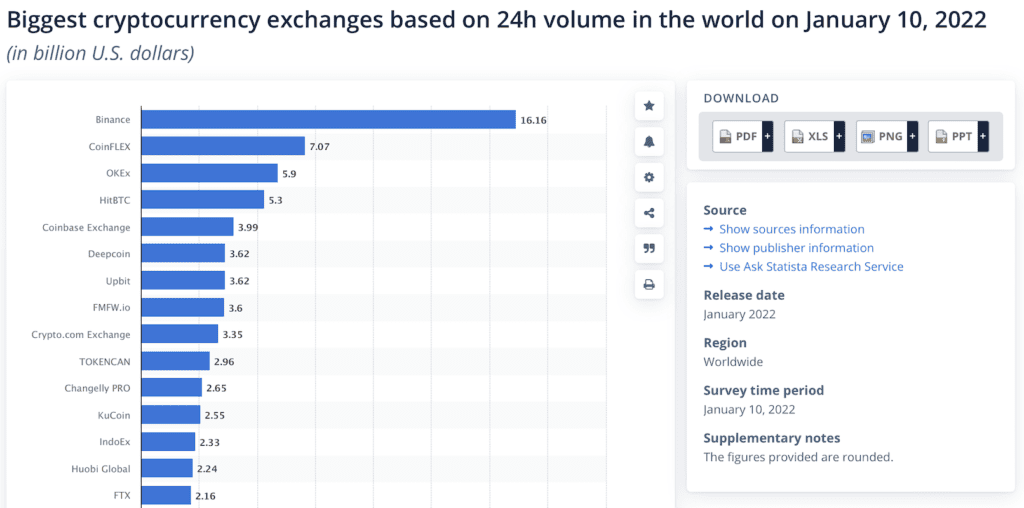 At the same time, we can count the most popular crypto trading apps on the fingers of one hand. Why is that? Why do we not see mobile apps for crypto trading dominating the App Store and Google Play charts? Because there’s a caveat.
At the same time, we can count the most popular crypto trading apps on the fingers of one hand. Why is that? Why do we not see mobile apps for crypto trading dominating the App Store and Google Play charts? Because there’s a caveat.
The Caveat
According to Apple’s App Store Review Guidelines, only approved financial institutions can have their crypto trading apps in the mobile store. This means you will need to obtain corresponding licenses or secure a strategic partnership with an established broker.
That alone is a mammoth undertaking. Since we do not provide legal advice, I suggest that you discuss the matter with a crypto-competent lawyer. One thing to check with experts would be an opportunity to start a crypto exchange in a crypto-friendly country while still targeting your target audience.
Another workaround is developing a p2p crypto-trading app — a platform where users can trade directly. Or you might consider creating a completely decentralized exchange like UniSwap or PancakeSwap.
Regardless of the scenario you pick, you will need to build a crypto trading app to onboard more users. We already purchase more stuff from our smartphones and tablets, and the trend is only strengthening. Therefore, a crypto exchange mobile app becomes a cornerstone of a successful crypto-trading business.
Must-Have Features of a Crypto Trading App
What are the principle features a crypto trading mobile app absolutely can’t do without? Some of these features are fundamental, while others make the customer’s life easier. To develop an application for crypto trading that’s able to magnetize users, you need to account for both.
Foundational features
First things first, you can’t do much crypto trading without a trading engine, which means you will need to develop an entire cryptocurrency exchange platform before you can start developing a cryptocurrency trading app for smartphones.
Also Read: How Much Does It Cost to Build a Crypto Exchange?
We covered the topic of how to create a crypto exchange in a separate blog. In this post, I’d like us to talk more about creating a customer-facing mobile app. Where do you need to shift your focus to create delightful and sticky user experiences on mobile platforms?
Principle features
I suggest we follow a typical user’s steps when engaging with a crypto trading app. Even though some of these features may seem too familiar, pay attention to the best practices to get away with some insight. I’ve played around with almost 20 crypto trading apps and yet have to find a perfect example.
Onboarding: registration, login, tutorial
Signup and login seem like the most boring options all of us have encountered countless times. At the same time, there are plenty of nuances to keep your design and development team busy.
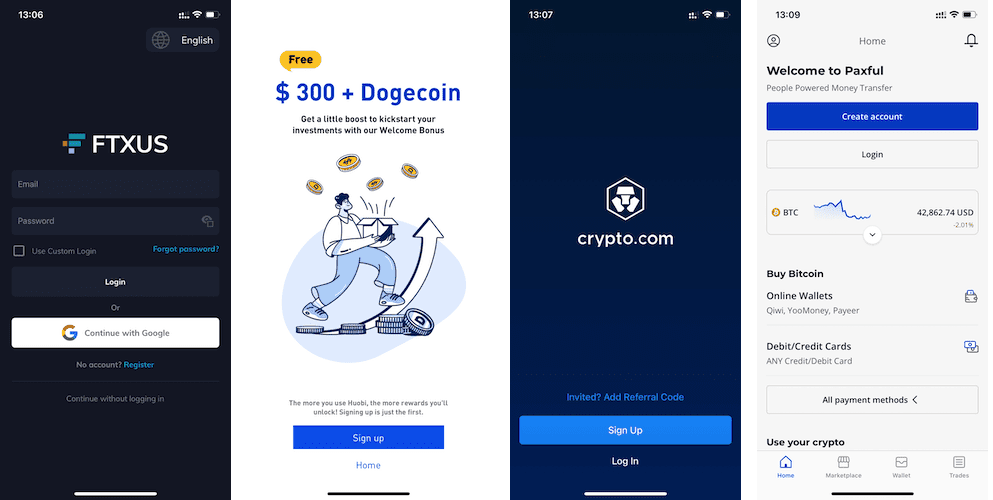
- registration
- login
- customer verification
- interactive tutorial
Not so many, right? So what’s there to discuss? The main challenge with onboarding features is that they stand in the way of customers using the app’s core features. On the other hand, you can’t avoid onboarding options altogether because the trading app won’t store user data and will become useless.
Onboarding best practices
- All fields should display prompts. People often rush through registration, and it’s easy to confuse, say, email and name fields.
- All fields should dynamically validate user inputs. For example, suppose the user has chosen a username that’s not allowed. In that case, there should be an immediate prompt to correct it.
- The keyboard layout should align with all fields. If we need to enter digits, show us just the numeric keyboard.
- Consider using Apple ID or similar services to speed up the creation of new accounts.
- One option is to land customers straight into the app without any registration at all. The registration dialog will trigger whenever we try to perform any meaningful action. Such an approach allows us to look around in the app without fully committing to anything.
- Avoid web view — a minified version of a web interface squeezed into a smartphone screen. That considerably degrades the user experience.
- Use out-of-the-box captcha tools optimized for mobile screens, e.g., GeeTest.
- Allow automatic prompts for adding verification codes from text messages.
- Automatically loop users in and out of the app using special links if they need to verify their account via email. No one likes all these taps.
- Ask to turn on Face ID or similar bio-authentication during the sign-up process.
- Use gender-neutral names, like anonymous users in Google Docs, if you want to automatically create usernames.
- Tapping outside the keyboard should always, always hide it. What often happens is the on-screen keyboard covers forms at the bottom of the screen, and there’s literally no way to switch to the next point (because “Enter” is only intuitive for app developers).
- Don’t push too many tutorials onto customers from the very start. Show and explain different options gradually, at their own pace.
Know Your Customer (KYC)
No one likes that, and it goes against the original idea of anonymous crypto transactions, but KYC procedures protect your customers from scams and bad actors.
The process is pretty straightforward and typically requires users to provide a state ID, driver’s license, or similar ID documents verifying their identity. Just like onboarding, KYC should run smoothly and as quickly as possible.
KYC best practices
- Use out-of-the-box solutions like netverify.com or jumio to accelerate the development process.
- Make sure customers can upload photos of their documents instead of taking yet another series of shots.
Market data
What do customers expect to see when they finally land on the main screen of your app? Why the list of crypto assets, of course! I agree that it doesn’t have to be a list (if you’re too creative), but the point is that customers need to see the state of the crypto market.
Based on this information, they’ll be able to decide their next move with buying, selling, or exchanging crypto assets.
Crypto market data best practices
- Design and develop your own charts instead of plugging in TradingView or other similar tools. Believe it or not, charts can make or break your entire app. I’ve played with solutions where I was literally afraid to touch a chart because it would either spit too much info on me or break the interface entirely.
- Do your customers need candlesticks or a line chart? I strongly advise you to scrutinize CoinMarketCap’s charts: they are exceptionally user-friendly and customizable.
- Think through how favorites, search, sorting, and filtering will work. Use gestures?
- Try to innovate how you present coins and tokens. Everybody is kind of used to seeing Bitcoin and Ethereum at the top, but what follows and in what shape and form is totally up to you.
Crypto trading per se
The next big chunk of functionality in any smartphone crypto trading application is trading itself. Users need self-explanatory options for buying, selling, and exchanging crypto tokens and cryptocurrencies. Besides that, you’ll need some fiat onramp option for customers to convert their fiat currencies into crypto money.
Will your customers prefer to slide across token symbols to execute immediate trades, fill in different fields and fine-tune various options, or use sliders for a quick input? You will only be able to answer such questions after developing and testing a prototype with select customers.
We’ll talk about prototyping in greater detail when discussing the steps to create a cryptocurrency trading app. In the meantime, let’s review what options you may include as part of the trading features in your app:
- exchange and market orders
- stop-loss orders, derivative and spot trades, and other advanced options
- order book
- margin trading
- bot trading
You can find more info on how to create a cryptocurrency trading bot in a separate blog.
No doubt, the trading experience in your app will totally depend on who will use the app: experienced traders or newbies, retail or enterprise players (read huge funds), etc. However, there are still some recommendations I can draw from analyzing 20 mobile crypto trading platforms.
Crypto trading best practices
- Avoid placing more than 5-7 clickable items on a single screen.
- Optimize the UX/UI to novice or experienced users and find an elegant way to toggle between these modes.
- Ensure that the interface reacts to every user tap: even if something is happening in the background, show the progress with spinners or similar design items.
- Allow sorting coins and tokens by most traded, market cap, price movement, etc.
- Boost the customer’s confidence by showing all relevant info about each traded crypto asset along with relevant news.
Portfolio tracking
Finally, users would love to see how assets they own gain (or lose) price appreciation. After all, mad gains possible in crypto is why they downloaded your app in the first place.
Crypto portfolio best practices
- show long-term and short-term portfolio performance
- highlight assets contributing to the portfolio growth
- allow customers to share their portfolios to stir some social networking
- import portfolio from other exchanges
Miscellaneous features
Even though the following features seem basic, each of them needs a lot of attention to craft the perfect user experience:
- cryptocurrency wallet (more on how to create a crypto wallet)
- user profile
- educational content
- referrals and bonuses
- notifications
What are some rule-of-thumb recommendations we can elicit here?
Best practices for miscellaneous features
- an easy way for customers to extract their crypto wallet address
- user profile options should be grouped into navigable sections
- include a rewards calculator for joining a referral program
- find the balance between too many and too few notifications
Advanced Features of a Crypto Trading App
If you are ready to make a cryptocurrency trading app, I’m sure you must have some cherry-on-top options on your mind. I won’t pretend I know everything, especially since every feature requires careful consideration.
Some of the options I noticed in other crypto trading apps include:
- recurring buys
- spot and derivative trades
- staking to earn interest
- NFT trading
- inclusion of brand-new tokens
- multiple payment options, e.g., gift cards (for p2p crypto trading)
Related: NFT App Development: Everything You Need to Know
How to make a P2P payment app: The Ultimate Guide
Related: read up on how to create a crypto token.
Steps to Develop a Crypto Trading App
Developing a crypto trading app is no different from any other application development, except for working with blockchain technology. We need to go through all the major stages:
- strategizing
- designing and prototyping
- writing code and testing
- public release
- maintaining and updating
Let’s review each step briefly.
Strategizing
The first step is to define your target audience, research its needs, and define the project scope in relation to your business goals. You can find more info on how we prefer to approach this step on our PreFlight Workshop page.
Strategy session outcomes:
- business plan
- prioritized feature list
- delivery plan
- high-level overview of tech components
Designing and prototyping
The design phase focuses on creating low-fidelity and high-fidelity wireframes that, in turn, become clickable prototypes. This approach guarantees that you won’t incur high development costs until verifying your app model with real users.
During this step, you’d also need to decide whether you want to combine the designs for pro investors and newbies into a single app or whether you prefer to target a specific user group.
To design a cryptocurrency trading application that customers will find engaging, you’ll have to work with UX/UI engineers with extensive fintech background.
Design phase outcomes:
- complete and tested app’s UX/UI
- interactive app prototype
Writing code and testing
Coding and testing would be a dud to any business owner unless they could get to play with their mobile app on their phones. In reality, that’s precisely what happens during the development and testing phase.
Ideally, your team follows the agile routine and ships an updated version of the app every two weeks while also providing full visibility into the development process. The QA team ensures no or minimum issues with the app by running automated and manual tests.
During this step, you connect the crypto trading to an existing exchange with a trading engine (on the back end) or develop the thing from scratch.
I’d also recommend using as many out-of-the-box services as possible for building basic features like notifications, authorization, KYC, and other non-crypto-related stuff offered by third-party services. That would speed up your cryptocurrency trading app development process by a lot.
Coding and testing outcomes:
- early app versions
- release candidates (an MVP version of the app ready for customers)
Related: MVP App Development: The Ultimate Guide
Public release
Launching the app to the public is when all the fun happens. I’m not sure if you’d have time to celebrate, though, amidst all the marketing craze. The development team helps you crawl through the App Store and Google Play app submission process, and the app becomes available for everybody.
Release phase outcomes:
- iOS and Android app versions uploaded to the mobile stores
- marketing collateral ready in the App Store and Google Play
Maintaining and updating
As you already know, every successful product keeps evolving over time. So planning for the long-term, you should account for setting up processes for updating the trading app and seamlessly rolling out updates to customers.
Please remember that updates don’t always come with fresh, exciting features introduced in new versions of mobile OSs. Sometimes that has to do with updating server components to ensure their stability and security.
Related: Read up on how to develop a blockchain payment solution.
The Cost of Creating a Crypto Trading App
An MVP of a mobile trading app would take between $100,000 and $150,000, provided that you already have a web-based crypto exchange with a trading engine and corresponding APIs. Building that from scratch would likely double the price.
Related: App Development Costs: Everything You Need to Know
Hopefully, you have found some insights on crypto trading app development. I encourage you to reach out if you still have any questions or would like to discuss how to develop your own crypto trading app.
Related Articles:
- Fintech App Development Guide
- How to Create a Fintech Startup
- How to Build a Budget App for Personal Finances
- DeFi App Development Guide
- How to Make a Banking Application
- Investing and Stock Trading App Development
[This blog was originally published on 1/26/2022 and has been updated with more recent content]
Frequently Asked Questions
Can a non-licensed financial organization develop a crypto trading app?
Only a peer-to-peer version of it, allowing customers to trade crypto with each other.
What's your take on the design challenge with targeting pro and novice crypto traders?
Some exchanges (like Kraken) develop separate apps. Others (like Binance) allow customers to switch between the light and pro interfaces within a single app. I like the second approach with the addition of qualifying customers during onboarding and presenting them with the fitting design.
What are the downsides of building a mobile crypto trading app with a fixed price approach?
You might end up with a solution that people don’t really need or know how to use. Plus, the time to market will be significantly longer than with an agile software development approach.
How is creating a crypto trading app different from creating a crypto exchange?
Think of it as developing a mobile front end, like when Google decided it was high time to build a native Gmail app for the iPhone.
How long does it take to build a crypto trading mobile app?
Around six months for an MVP and nine to twelve months for a feature-rich application.
